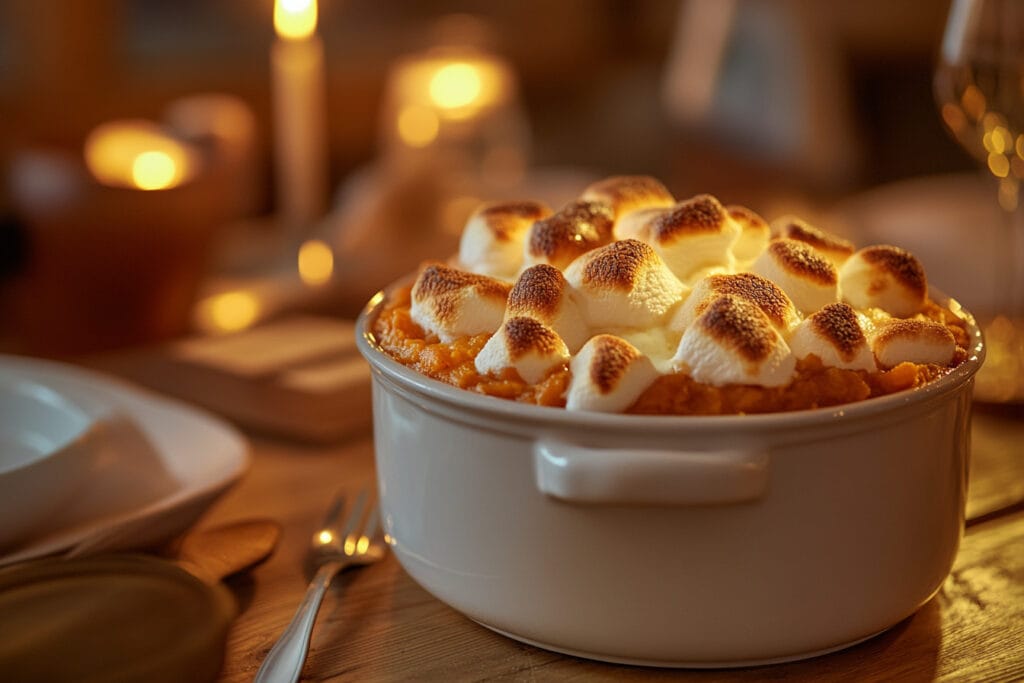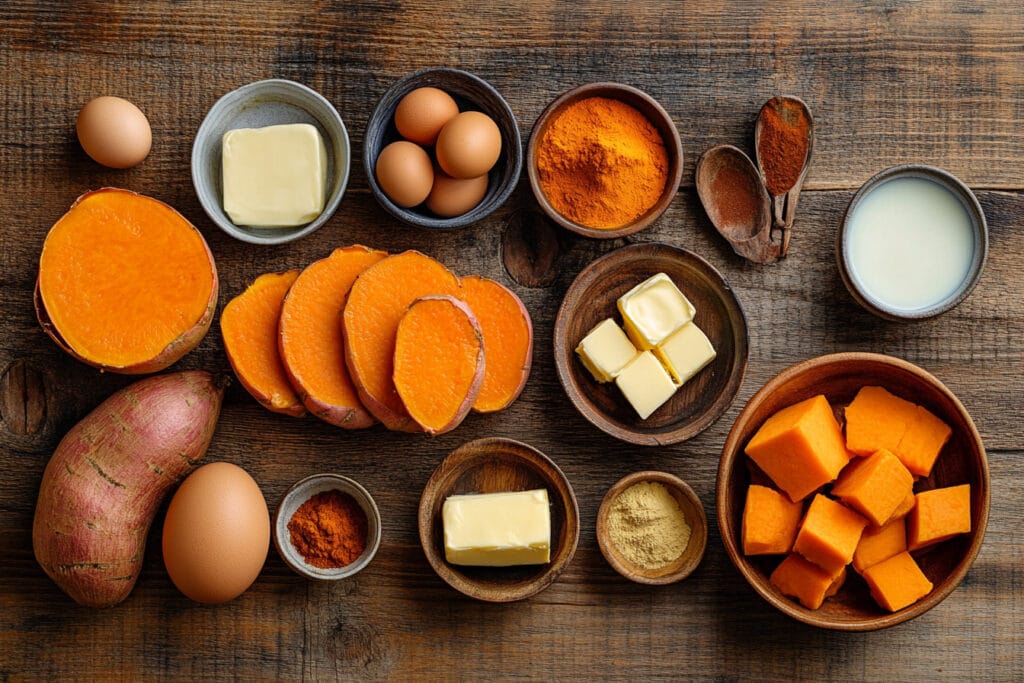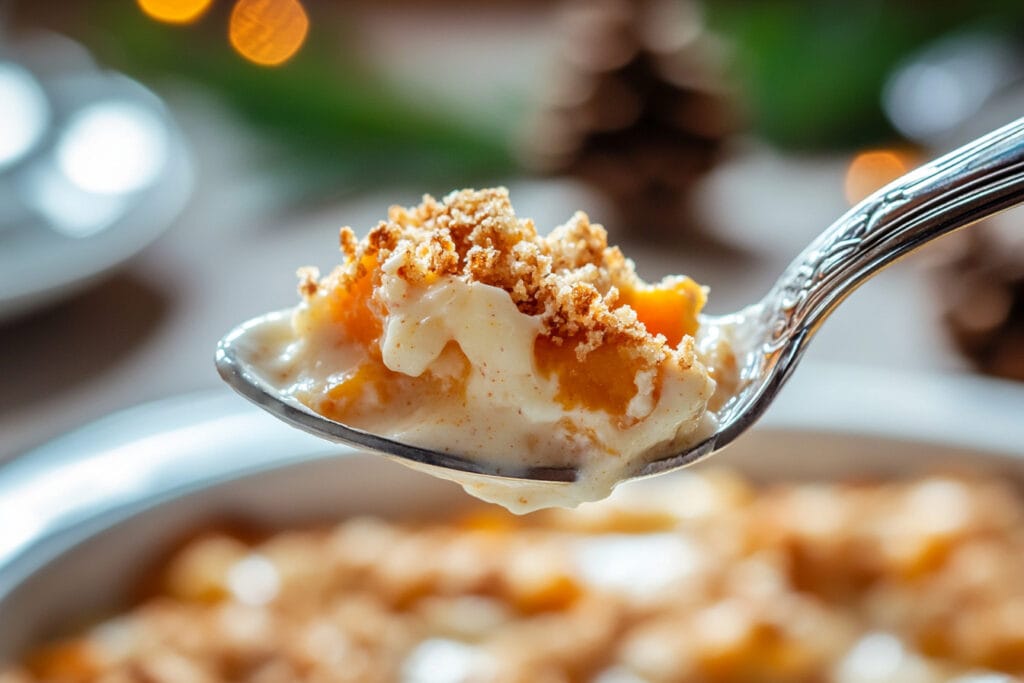
Sweet potato casserole is a classic dish that graces dinner tables during the holiday season. It’s creamy, sweet, and often topped with marshmallows or crunchy pecans, making it a favorite for people of all ages. But sometimes, you may find that your sweet potato casserole turns out watery, ruining the texture and overall experience of the dish. This can be frustrating, especially when you’re cooking for guests or a special occasion.
What is Sweet Potato Casserole?
The Basics of Sweet Potato Casserole
Sweet potato casserole is a comforting, crowd-pleasing dish made primarily from mashed sweet potatoes, sugar or sweeteners, and various spices. The dish is baked until warm and creamy and often topped with marshmallows, nuts, or a crumbly streusel topping. It’s a staple in many households, particularly during Thanksgiving and Christmas.
The beauty of this dish lies in its versatility. Some recipes lean toward the sweet side, treating the casserole almost like a dessert, while others take a more savory approach with spices like nutmeg, cinnamon, or even a hint of black pepper.
Sweet potato casserole is a comforting, crowd-pleasing dish made primarily from mashed sweet potatoes, sugar or sweeteners, and various spices. The dish is baked until warm and creamy and often topped with marshmallows, nuts, or a crumbly streusel topping. It’s a staple in many households, particularly during Thanksgiving and Christmas.
The beauty of this dish lies in its versatility. Some recipes lean toward the sweet side, treating the casserole almost like a dessert, while others take a more savory approach with spices like nutmeg, cinnamon, or even a hint of black pepper.
Common Ingredients and Their Roles
To understand why a sweet potato casserole might get watery, it’s helpful to know what each ingredient does in the recipe. Here are the key players:
- Sweet Potatoes: The star of the dish. When boiled or baked, sweet potatoes soften and release moisture, creating the creamy texture we all love.
- Milk or Cream: Adds richness and smoothness but can make the casserole runny if too much is added.
- Butter: Provides flavor and helps bind the ingredients together.
- Eggs: Often included as a binder to help the casserole set and hold its shape.
- Sweeteners (Sugar, Maple Syrup, or Honey): Enhances the natural sweetness of the potatoes but doesn’t affect the texture much.
- Toppings (Marshmallows, Pecans, or Streusel): Adds flavor and texture, making the casserole extra special.
If these ingredients aren’t balanced properly, you might end up with an overly watery dish or one that doesn’t hold its shape. In the next section, we’ll explore what causes this issue and how to fix it.

Creative Variations of Sweet Potato Casserole
Adding a Savory Twist
While most sweet potato casseroles lean toward the sweet side with marshmallows, brown sugar, and pecans, you can try a savory variation to shake things up. A savory casserole uses ingredients like garlic, herbs, and cheese to balance the natural sweetness of the sweet potatoes. Here’s how you can make it:
- Cheese: Add shredded sharp cheddar or parmesan to the mashed sweet potatoes and mix well. Top the casserole with a layer of cheese for a golden, bubbly crust.
- Herbs: Incorporate fresh rosemary, thyme, or parsley for an earthy, aromatic flavor.
- Spices: Add a pinch of smoked paprika or ground cumin for a subtle, savory kick.
- Toppings: Swap out marshmallows for breadcrumbs or crushed crackers mixed with butter for a crunchy, savory topping.
This variation is perfect for those who prefer a less sweet side dish or are looking for something new to try at their dinner table.
Vegan and Dairy-Free Options
If you’re cooking for someone with dietary restrictions or just want a lighter option, you can easily adapt sweet potato casserole to be vegan or dairy-free. Here’s how:
- Milk Alternatives: Use almond milk, coconut milk, or oat milk instead of dairy milk. Make sure to choose unsweetened and unflavored varieties.
- Butter Alternatives: Replace butter with coconut oil or a vegan butter substitute to maintain the richness of the dish.
- Egg Substitutes: Use flax eggs (1 tablespoon of ground flaxseed mixed with 2.5 tablespoons of water per egg) or chia eggs for binding. These options will keep the casserole’s texture intact.
- Toppings: Use chopped nuts, seeds, or a vegan streusel topping made with oats and coconut oil instead of marshmallows.
This version of sweet potato casserole is just as delicious and ensures that everyone at the table can enjoy the dish.
Adding Unique Flavors
To give your sweet potato casserole a personal touch, consider experimenting with unique flavors and textures. Here are a few ideas:
- Citrus Zest: Add orange or lemon zest to the mashed sweet potatoes for a bright, tangy flavor.
- Maple Syrup: Use pure maple syrup as a sweetener to enhance the natural flavor of the sweet potatoes.
- Spiced Nuts: Mix your pecans or walnuts with cinnamon, cayenne pepper, or a touch of chili powder for a sweet-and-spicy crunch.
- Dried Fruits: Add dried cranberries, raisins, or chopped dates to the casserole for bursts of sweetness and texture.
Sweet Potato Casserole as a Dessert
If you’re in the mood for a full dessert experience, you can transform sweet potato casserole into a decadent treat. To do this, increase the amount of sugar or sweeteners in the recipe and use dessert-inspired toppings. For example:
- Marshmallow Flambé: Torch the marshmallows on top for a gooey, caramelized finish.
- Caramel Sauce: Drizzle caramel or butterscotch sauce over the casserole before serving.
- Chocolate Chips: Sprinkle chocolate chips over the top for a chocolaty twist.
- Whipped Cream: Serve with a dollop of whipped cream or a scoop of vanilla ice cream for a luxurious dessert.
These creative variations ensure that sweet potato casserole can fit any occasion, from a family dinner to a festive holiday meal. Experimenting with new flavors and approaches will keep this classic dish fresh and exciting year after year.
Common Causes of a Watery Sweet Potato Casserole
Improper Preparation of Sweet Potatoes
One of the biggest culprits behind a watery casserole is the improper preparation of sweet potatoes. Sweet potatoes naturally contain a lot of water, and if they aren’t cooked or drained correctly, that water can seep out during baking, making the dish runny.
- Boiling vs. Baking: Boiling sweet potatoes can cause them to absorb extra water, especially if they are overcooked. Baking them instead reduces excess moisture and brings out their natural sweetness.
- Insufficient Draining: After boiling or steaming sweet potatoes, it’s crucial to drain them thoroughly. Even a little leftover water can create a watery consistency.
Excess Liquid in the Recipe
Sometimes, the problem lies in the recipe itself. Adding too much milk, cream, or even butter can tip the balance and make the dish too runny. The key is to measure these ingredients carefully and follow the recipe’s instructions closely.
Incorrect Baking Time or Temperature
The way you bake your casserole also plays a role. If the oven temperature is too low, the casserole may not cook through, leaving excess liquid. Similarly, underbaking the dish can result in a watery texture because the ingredients haven’t had enough time to bind together.

How to Avoid a Watery Sweet Potato Casserole
Draining Sweet Potatoes Properly
After cooking your sweet potatoes, let them sit in a colander for at least 5–10 minutes to allow all the excess water to drain away. If you want to be extra thorough, you can even pat them dry with a clean kitchen towel before mashing.
Measuring Ingredients Accurately
Use measuring cups and spoons to ensure you’re not adding too much milk, cream, or butter. Many recipes call for a specific amount of liquid, and even a small deviation can affect the texture. Stick to the recommended quantities and avoid eyeballing it.
Adjusting the Recipe for Your Oven
Every oven is different, and baking times may vary. If you notice that your casserole often turns out watery, try baking it at a slightly higher temperature or for a few extra minutes. A good starting point is to increase the temperature by 15°F and check the dish frequently toward the end of the baking time.
Heading 2: Tips for a Perfect Sweet Potato Casserole
Using High-Quality Ingredients
One of the simplest ways to ensure your sweet potato casserole turns out perfectly is to start with high-quality ingredients. Fresh sweet potatoes that are firm and free of blemishes provide the best flavor and texture. Avoid canned sweet potatoes if possible, as they often contain added water and preservatives, which can increase the risk of a watery casserole.
The quality of your milk, cream, butter, and eggs also matters. Opt for whole milk or heavy cream for a richer, thicker consistency. Using unsalted butter allows you to control the flavor better, while fresh eggs ensure the dish binds properly.
Adding Thickeners Like Flour or Cornstarch
If you’re worried about the casserole being too watery, consider incorporating a thickening agent like flour or cornstarch into the recipe. A tablespoon of flour or cornstarch mixed into the mashed sweet potatoes can absorb excess moisture and help the dish set as it bakes. Be sure to mix it in thoroughly to avoid lumps.
Another option is to use breadcrumbs in the topping. They not only add a delicious crunch but also help soak up any liquid that may bubble up during baking.
Testing the Casserole Before Serving
Before serving your casserole, it’s a good idea to test its consistency. Gently press the center with a spoon or spatula—if it’s too loose or jiggly, bake it for an additional 5–10 minutes. You can also insert a toothpick or skewer into the middle; if it comes out clean, the casserole is ready.
Frequently Asked Questions (FAQs)
Why Does Sweet Potato Casserole Get Watery?
Sweet potato casserole is a cherished side dish, but it can sometimes turn out watery, affecting its consistency and flavor. Here’s an FAQ that dives into why this happens and how to fix it.
Why Do Sweet Potatoes Release Water?
Sweet potatoes naturally contain a lot of water, which is released when they’re cooked. If they aren’t drained or mashed properly, this water can mix into your casserole and affect the texture. Overboiling sweet potatoes also increases the amount of water they absorb. For a better result, consider baking them instead, as suggested in Is it better to bake or boil sweet potatoes for casserole?, where baking is recommended to enhance flavor and texture while limiting excess moisture.
Can I Fix a Watery Sweet Potato Casserole?
Yes, you can fix a watery casserole! If you notice the issue before serving, return it to the oven and bake it uncovered at a slightly higher temperature for 10–15 minutes. This will help evaporate the excess moisture. Alternatively, sprinkling a small amount of breadcrumbs or crushed crackers over the top can help absorb some of the liquid. This technique is similar to how the topping is crafted in dishes like the Savannah Classics Sweet Potato Casserole, which achieves balance with a crunchy, absorbent topping.
Is It Okay to Prepare the Dish Ahead of Time?
Absolutely! Sweet potato casserole is a great make-ahead dish. However, if you prepare it in advance, be cautious about adding too much liquid, as the sweet potatoes may release moisture while the dish sits. Store it in the refrigerator and bake it fresh before serving for the best results. For more inspiration on make-ahead casseroles, consider exploring the Sweet and Savory Pineapple Casserole Recipe, which can also be prepared in advance.
Do I Need to Use Eggs in My Casserole?
Eggs aren’t mandatory, but they help bind the ingredients together and give the casserole structure. If you want a firmer texture, include one or two eggs in the recipe. For an egg-free version, you can use a flaxseed or chia seed substitute, though the texture might be slightly different. This consideration for binding is also highlighted in the preparation of Savannah Classics Sweet Potato Casserole, where eggs play a vital role in its light yet cohesive structure.
What’s the Best Way to Store Leftovers?
Store leftover sweet potato casserole in an airtight container in the refrigerator for up to 4 days. To reheat, place it in the oven at 350°F until warmed through. Avoid reheating in the microwave if possible, as it can make the texture soggy. This is particularly important when dealing with toppings like those found in Sweet and Savory Pineapple Casserole, where crispness is key.
Why Is My Casserole Dry Instead of Watery?
A dry casserole usually means there wasn’t enough liquid in the recipe or it was overbaked. To fix this issue, you can drizzle a small amount of melted butter or cream over the top before reheating. Covering the dish with foil during baking can also prevent it from drying out. For guidance on achieving the perfect balance, refer to tips in Is it better to bake or boil sweet potatoes for casserole?, where methods for optimal texture are discussed.
Conclusion
Sweet potato casserole is a beloved dish that deserves a spot on every holiday table. While a watery casserole can be disappointing, it’s a problem that’s easy to solve with the right techniques. By properly preparing your sweet potatoes, measuring ingredients accurately, and adjusting your baking time and temperature, you can achieve a casserole that’s creamy, flavorful, and perfectly set.
Remember to experiment with different toppings and thickeners to customize the dish to your liking. Whether you’re serving it to family or guests, these tips will ensure your sweet potato casserole is a hit every time.
